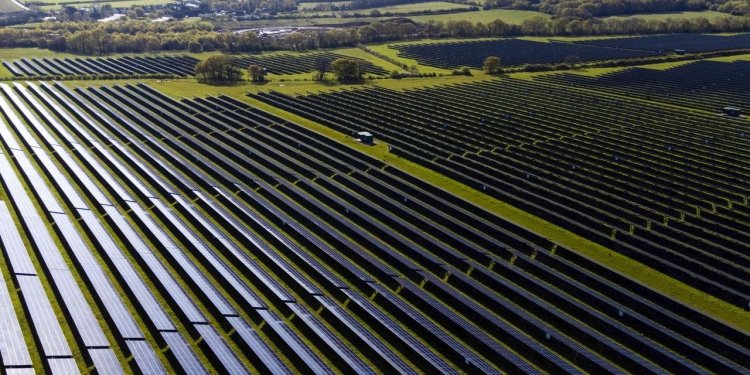Oil Demand to Peak This Decade as EVs Boom, IEA Says
Developed countries are quickly switching to cleaner sources of energy such as solar power. Photo: Chris Ratcliffe/Bloomberg News By Will Horner June 14, 2023 4:36 am ET Rising demand for crude oil is set to slow to a trickle within five years and peak before the end of the decade, as electric-vehicle uptake surges and developed nations rapidly transition to cleaner sources of energy, according to a prominent energy forecaster. The International Energy Agency, a group funded by some of the world’s largest oil consumers, expects demand for transport fuels derived from oil such as gasoline will be the first to peak before starting a steady decline—hastened by a sharp uptick in EVs and a long-lasting shift to remote working spurred on by the Covid-19 pandemic. Rapidly growing Asian e


Developed countries are quickly switching to cleaner sources of energy such as solar power.
Photo: Chris Ratcliffe/Bloomberg News
By
Rising demand for crude oil is set to slow to a trickle within five years and peak before the end of the decade, as electric-vehicle uptake surges and developed nations rapidly transition to cleaner sources of energy, according to a prominent energy forecaster.
The International Energy Agency, a group funded by some of the world’s largest oil consumers, expects demand for transport fuels derived from oil such as gasoline will be the first to peak before starting a steady decline—hastened by a sharp uptick in EVs and a long-lasting shift to remote working spurred on by the Covid-19 pandemic.
Rapidly growing Asian economies will continue to prop up the global appetite for oil in the coming years, and demand for jet fuel, naphtha and other oil products with industrial uses will continue to tick higher, the IEA said in a report released Wednesday. But even in China, which has long been the powerhouse of global oil demand, the appetite for crude will slow markedly before the end of the decade. India will surpass China as the main driver of oil growth as soon as 2027, the IEA said.
The forecast, which the IEA made in an annual report that considers oil demand as far away as 2028, isn’t the first time the Paris-based group has laid out a timeline predicting a zenith for oil. But it envisages a far more rapid shift away from fossil fuels than previously expected—a shift that has been sharply accelerated by the Covid-19 pandemic and the energy crisis that followed Russia’s invasion of Ukraine.
“The shift to a clean-energy economy is picking up pace, with a peak in global oil demand in sight before the end of this decade,” said Fatih Birol, the IEA’s executive director.
The forecasts are based on sharply diverging energy trends between the developed economies of North America and Europe and rapidly growing developing nations, predominantly those in Asia. Demand for oil in the advanced economies that make up the Organization for Economic Cooperation and Development is likely to peak as soon as this year thanks to vast government spending aimed at reconfiguring economies away from fossil fuels, the IEA said.
Demand from those economies is expected to decline to 44.3 million barrels a day by 2028 from its peak of 46.2 million barrels a day in 2023. Demand in non-OECD nations will climb by more than 7% between now and 2028, to 61.4 million barrels a day.

Nickel is an essential component of electric-vehicle batteries and Indonesia is by far the world’s largest producer. A rare visit to one of its biggest nickel plants reveals the heavy environmental cost of mining and processing the metal. Photo: Ulet Ifansasti
The outlook for oil demand looks sharply different in the near term as Asian economies, notably China’s, ramp up demand following the easing of pandemic-era lockdown measures. In a separate monthly report, also released Wednesday, the IEA lifted its forecast for oil-demand growth this year by 200,000 barrels a day, to 2.4 million barrels a day.
China is set to account for 60% of that increase. Its demand hit a record of 16.3 million barrels a day in April, while India’s demand for gasoline and diesel also hit record levels in May.
SHARE YOUR THOUGHTS
How do you expect the oil market to change in the long term? Join the conversation below.
The IEA raised its 2023 oil-supply forecasts by 200,000 barrels a day to 101.3 million barrels a day and it expects further supply growth of 1 million barrels a day in 2024. Still, supplies are expected to struggle to keep pace with demand at least in the near term, the IEA expects—a situation that will sharply tighten the oil market and could send prices higher.
Oil-demand growth will begin to ease as soon as 2024, however; demand should increase by 860,000 barrels a day next year, the IEA expects. Oil demand will grow by a further 1 million barrels a day in 2025 after which the rate will begin to cool notably, increasing by just 700,000 barrels a day in 2026 and 500,000 barrels a day in 2027.
Write to Will Horner at [email protected]
What's Your Reaction?













